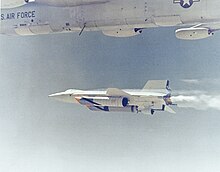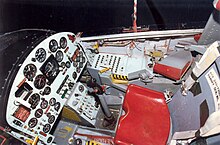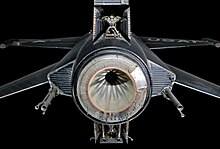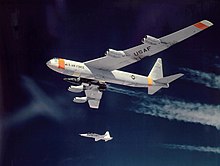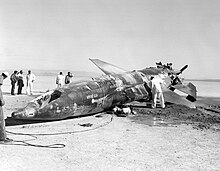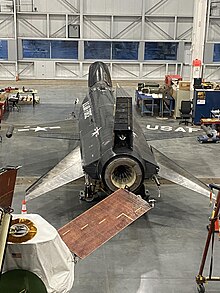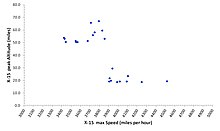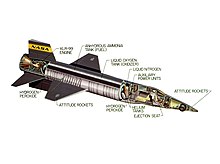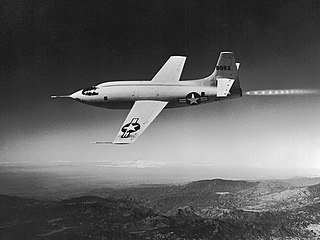
The Bell X-1 is a rocket engine–powered aircraft, designated originally as the XS-1, and was a joint National Advisory Committee for Aeronautics–U.S. Army Air Forces–U.S. Air Force supersonic research project built by Bell Aircraft. Conceived during 1944 and designed and built in 1945, it achieved a speed of nearly 1,000 miles per hour in 1948. A derivative of this same design, the Bell X-1A, having greater fuel capacity and hence longer rocket burning time, exceeded 1,600 miles per hour in 1954. The X-1 aircraft #46-062, nicknamed Glamorous Glennis and flown by Chuck Yeager, was the first piloted airplane to exceed the speed of sound in level flight and was the first of the X-planes, a series of American experimental rocket planes designed for testing new technologies.

A scramjet is a variant of a ramjet airbreathing jet engine in which combustion takes place in supersonic airflow. As in ramjets, a scramjet relies on high vehicle speed to compress the incoming air forcefully before combustion, but where as a ramjet decelerates the air to subsonic velocities before combustion using shock cones, a scramjet has no shock cone and slows the airflow using shockwaves produced by its ignition source in place of a shock cone. This allows the scramjet to operate efficiently at extremely high speeds.
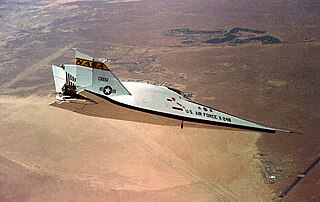
The Martin Marietta X-24 was an American experimental aircraft developed from a joint United States Air Force-NASA program named PILOT (1963–1975). It was designed and built to test lifting body concepts, experimenting with the concept of unpowered reentry and landing, later used by the Space Shuttle. Originally built as the X-24A, the aircraft was later rebuilt as the X-24B.

The NASA Neil A. Armstrong Flight Research Center (AFRC) is an aeronautical research center operated by NASA. Its primary campus is located inside Edwards Air Force Base in California and is considered NASA's premier site for aeronautical research. AFRC operates some of the most advanced aircraft in the world and is known for many aviation firsts, including supporting the first crewed airplane to exceed the speed of sound in level flight, highest speed by a crewed, powered aircraft, the first pure digital fly-by-wire aircraft, and many others. AFRC operates a second site next to Air Force Plant 42 in Palmdale, California, known as Building 703, once the former Rockwell International/North American Aviation production facility. There, AFRC houses and operates several of NASA's Science Mission Directorate aircraft including SOFIA, a DC-8 Flying Laboratory, a Gulfstream C-20A UAVSAR and ER-2 High Altitude Platform. As of 2023, Bradley Flick is the center's director.

The Boeing X-20 Dyna-Soar was a United States Air Force (USAF) program to develop a spaceplane that could be used for a variety of military missions, including aerial reconnaissance, bombing, space rescue, satellite maintenance, and as a space interceptor to sabotage enemy satellites. The program ran from October 24, 1957, to December 10, 1963, cost US$660 million, and was cancelled just after spacecraft construction had begun.

The NASA X-43 was an experimental unmanned hypersonic aircraft with multiple planned scale variations meant to test various aspects of hypersonic flight. It was part of the X-plane series and specifically of NASA's Hyper-X program developed in the late 1990s. It set several airspeed records for jet aircraft. The X-43 is the fastest jet-powered aircraft on record at approximately Mach 9.6.

Joseph Albert Walker was an American World War II pilot, experimental physicist, NASA test pilot, and astronaut who was the first person to fly an airplane to space. He was one of twelve pilots who flew the North American X-15, an experimental spaceplane jointly operated by the Air Force and NASA.

Albert Scott Crossfield was an American naval officer and test pilot. In 1953, he became the first pilot to fly at twice the speed of sound. Crossfield was the first of twelve pilots who flew the North American X-15, an experimental spaceplane jointly operated by the United States Air Force and NASA.

Michael James Adams was an American aviator, aeronautical engineer, and USAF astronaut. He was one of twelve pilots who flew the North American X-15, an experimental spaceplane jointly operated by the Air Force and NASA.

X-15 Flight 91 was an August 22, 1963 American crewed sub-orbital spaceflight, and the second and final flight in the program to fly above the Kármán line, which was previously achieved during Flight 90 a month earlier by the same pilot, Joseph A. Walker. It was the highest flight of the X-15 program.

William John "Pete" Knight was an American aeronautical engineer, politician, Vietnam War combat pilot, test pilot, and astronaut. He was one of twelve pilots who flew the North American X-15, an experimental spaceplane jointly operated by the U.S. Air Force and NASA. He was also selected for participation in the X-20 Dyna-Soar program.

John Barron McKay was an American naval officer, World War II pilot, aeronautical engineer, test pilot, and astronaut. He was one of twelve pilots who flew the North American X-15, an experimental spaceplane jointly operated by the United States Air Force and NASA. On September 28, 1965, he flew the X-15 to an altitude of 295,600 feet (90,100 m), thereby qualifying as an astronaut according to the United States definition of the boundary of space. However, this altitude did not surpass the Kármán line as defined by the FAI, the FAI-accepted boundary of 100 kilometres (62.1 mi).

The Northrop HL-10 was one of five US heavyweight lifting body designs flown at NASA's Flight Research Center in Edwards, California, from July 1966 to November 1975 to study and validate the concept of safely maneuvering and landing a low lift-over-drag vehicle designed for reentry from space. It was a NASA design and was built to evaluate "inverted airfoil" lifting body and delta planform. It currently is on display at the entrance to the Armstrong Flight Research Center at Edwards Air Force Base.

The Northrop M2-F2 was a heavyweight lifting body based on studies at NASA's Ames and Langley research centers and built by the Northrop Corporation in 1966.

X-15 is a 1961 American aviation drama film that presents a fictionalized account of the X-15 research rocket aircraft program, the test pilots who flew the aircraft, and the associated NASA community that supported the program. X-15 starred David McLean, Charles Bronson, James Gregory and Mary Tyler Moore. The film marked the feature film directorial debut of Richard Donner, and was narrated by James Stewart.

The Boeing X-51 Waverider is an unmanned research scramjet experimental aircraft for hypersonic flight at Mach 5 and an altitude of 70,000 feet (21,000 m). The aircraft was designated X-51 in 2005. It completed its first powered hypersonic flight on 26 May 2010. After two unsuccessful test flights, the X-51 completed a flight of over six minutes and reached speeds of over Mach 5 for 210 seconds on 1 May 2013 for the longest duration powered hypersonic flight.
Scramjet programs refers to research and testing programs for the development of supersonic combustion ramjets, known as scramjets. This list provides a short overview of national and international collaborations, and civilian and military programs. The USA, Russia, India, and China (2014), have succeeded at developing scramjet technologies.

X-15 Flight 3-65-97, also known as X-15 Flight 191, was a sub-orbital spaceflight of the North American X-15 experimental spaceplane, carrying seven experiments to a peak altitude of 266,000 feet, above NASA's definition of the start of space at 50 miles (80 km) but below the Kármán line definition at 62 miles (100 km). The flight, on November 15, 1967, ended when the aircraft broke apart minutes after launch due to technical difficulties, killing the pilot Michael J. Adams and destroying the aircraft.

The North American X-15's Flight 188 on October 3, 1967, was a record-setting flight. William J. Knight took the X-15A-2 hypersonic rocket-powered aircraft to 102,100 feet over Mud Lake, Nevada when Flight 188 reached a record-setting top speed of 4,520 mph (7,270 km/h), Mach 6.70.


